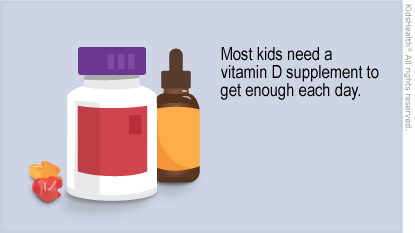Vitamin D: Caring for Your Child
Vitamin D is a nutrient that helps the body take in calcium from the foods that we eat. Together, calcium and vitamin D build bones and keep them strong. Even when kids eat a healthy diet, it's hard for them to get enough vitamin D from foods. So give a vitamin D supplement (sometimes labeled vitamin D3) to help your child develop strong bones.


Babies under 1 year old need 400 IU (international units) of vitamin D each day:
-
Breast milk is best for babies, but it doesn't have enough vitamin D. If your baby drinks breast milk, give vitamin D drops or a multivitamin drop that has vitamin D.
-
Formula has vitamin D added. Babies who drink 32 ounces or more of formula each day don't need a vitamin D supplement.
Kids over 1 year old and teens need 600 IU or more of vitamin D each day:
-
Most kids need 600 to 1,000 IU daily, but some need more. Ask your health care provider about the right amount of vitamin D for your child.
-
If your child doesn't get enough vitamin D through food, give a supplement. You can buy vitamin D pills, gummies, chewables, oral drops, and sprays in stores without a prescription. Ask your health care provider for advice on choosing the right one.
Protect your child's skin with sunscreen, clothing, and shade. In addition to foods and supplements, people get vitamin D from sun exposure. But too much sun exposure raises kids' risk for skin cancer later in life. So protect skin to prevent skin cancer and early aging.


What foods have vitamin D? Very few foods have vitamin D naturally. The foods with the most vitamin D are fish (like salmon and tuna), liver, eggs, and cod liver oil. Most kids don't eat these foods a lot. That's why food companies add vitamin D to milk, yogurt, baby formula, juice, cereal, and other foods. Adding vitamin D to foods is called "fortifying." This is helpful, but it still may not be enough.
How do I know if my kids are getting enough vitamin D? Health care providers will recommend supplements or diet changes if they think kids aren't getting enough of the vitamins and minerals they need. They might order a blood test if they think a health condition is part of the problem. Otherwise, there's no need for a blood test.
Things that can affect vitamin D levels include:
-
obesity, celiac disease, cystic fibrosis, kidney or liver disease
-
healing from bone surgery (such as fusion surgery for scoliosis)
-
some medicines (like anti-seizure medicines) that block the way the body uses vitamin D
Your health care provider will advise you if any of these medical conditions affect your child.
What about calcium? Vitamin D helps the body absorb calcium. Unlike with vitamin D, kids usually can get enough calcium from food. High-calcium foods include milk, cheese, and yogurt. Food makers often fortify foods like cereal, bread, or juice with calcium.